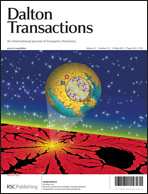Four ruthenium(II) complexes, BPT, BPN, BPPT, and BPPN, have been prepared and characterized by 1H NMR, 13C NMR, high resolution mass spectrometry (HRMS), elemental analysis, and X-ray crystallography. All the complexes incorporate a pyridyl unit on the terpyridine-type or N-heterocyclic carbene (NHC) ligand and the pyridyl unit can be protonated upon addition of 1.0 M HCl in diethyl ether. The proton-dependent absorption and luminescence spectrum were measured in CH3CN. In the case of BPT, the λmaxabs was moved by 10 nm from 490 nm to 500 nm after the addition of 12 equiv. of HCl and the intensity of the emission spectrum increased. In contrast, in the case of BPN, the λmaxabs was red-shifted by 43 nm from 424 nm to 467 nm and the emission was dramatically quenched upon the addition of the equiv. of HCl. However, there were no noticeable changes in the λmaxabs values of BPPT and BPPN even after the addition of the HCl to a solution of those complexes. Moreover, BPN has a selective sensing property for a proton among many cations.

You have access to this article
 Please wait while we load your content...
Something went wrong. Try again?
Please wait while we load your content...
Something went wrong. Try again?


 Please wait while we load your content...
Please wait while we load your content...